Gallery
- Berckentin Mansion (1751–55
- Dehn Mansion (1751–55
- Gråsten Palace (1758–59)
- Augustenborg Castle (1770–76).
Johann Gottfried Rosenberg (late 1709 - 4 June 1776) was a German-Danish architect working in the Rococo style.
Johann Gottfried Rosenberg's exact date of birth is not known but he was christened on 20 October 1709 in Woldegk in the duchy of Mecklenburg-Strelitz. In the 1730s, he was active in Schleswig-Holstein and from 1740 in Denmark where he settled in 1752. His early works include the Margård manor house on the island of Funen which relies on French country house architecture for inspiration. [1]
He collaborated with Nicolai Eigtved on a number of projects in Copenhagen in the early 1750s, including the Dehn, Bernstorff and Berckentin Mansions in Bredgade in the Frederiksstaden neighbourhood which was under development around that time. North of the city, on the shore of Lake Bagsværd, he designed the Frederiksdal pavilion. [1]
In 1760, Rosenborg returned to Schleswig-Holstein to assume a position as master builder. His most important works there are Gråsten Palace (1758–59) and Augustenborg Castle (attributed, 1770–76). In 1771 he finished the Royal Danish Mint in Altona (Elbe) near Hamburg.

Augustenborg is a town on Als Island in Sønderborg Municipality, Region of Southern Denmark in Denmark. The town lies at the head of Als Fjord. To the east is the Little Belt. Ferry service connects Augustenborg to the island of Funen from the nearby town of Fynshav.

Christian VII was a monarch of the House of Oldenburg who was King of Denmark–Norway and Duke of Schleswig and Holstein from 1766 until his death in 1808. For his motto he chose: "Gloria ex amore patriae".

Frederick IV was the king of Denmark and Norway from 1699 until his death. Frederick was the son of Christian V of Denmark-Norway and his consort Charlotte Amalie of Hesse-Kassel.

Als is a Danish island in the Baltic Sea.

The House of Schleswig-Holstein-Sonderburg-Augustenburg was a branch of the dukes of Schleswig-Holstein-Sonderburg of the House of Oldenburg. The line descended from Alexander, Duke of Schleswig-Holstein-Sonderburg. Like all of the secondary lines from the Sonderburg branch, the heads of the House of Schleswig-Holstein-Sonderburg-Augustenburg were first known as Dukes of Schleswig-Holstein and Dukes of Sonderburg. The family took its name from its ancestral home, Augustenborg Palace in Augustenborg, Denmark.

Princess Louise Augusta of Denmark and Norway was the daughter of the Queen of Denmark, Caroline Matilda of Great Britain. Though officially regarded as the daughter of King Christian VII, it is widely accepted that her biological father was Johann Friedrich Struensee, the king's royal physician and de facto regent of the country at the time of her birth. She was referred to sometimes as "la petite Struensee"; this did not, however, have any effect on her position.
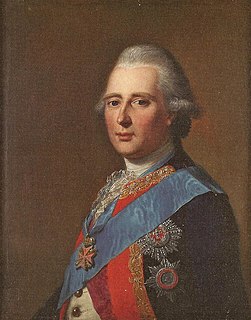
Prince Charles of Hesse-Kassel, German and Norwegian: Karl; 19 December 1744 – 17 August 1836) was a cadet member of the house of Hesse-Kassel and a Danish general field marshal. Brought up with relatives at the Danish court, he spent most of his life in Denmark, serving as royal governor of the twin duchies of Schleswig-Holstein from 1769 to 1836 and commander-in-chief of the Norwegian army from 1772 to 1814.

Christian August II, Duke of Schleswig-Holstein-Sonderburg-Augustenburg, commonly known as Christian, Duke of Augustenborg, was a German prince and statesman. During the 1850s and 1860s, he was a claimant to the provinces of Schleswig and Holstein, and a candidate to become king of Denmark following the death of King Frederick VII. He was the father-in-law of Princess Helena and the paternal grandfather of Augusta Victoria, Empress of Germany and wife of Kaiser Wilhelm II.
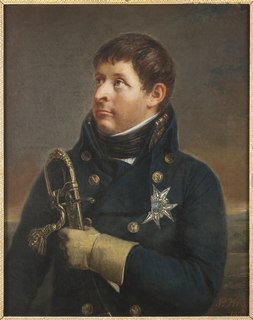
Charles August or Carl August was a Danish prince. He is best known for serving as Crown Prince of Sweden briefly in 1810, adopted by Charles XIII, before his sudden death from stroke. Earlier, he had been a general in the Royal Danish Army as well as the Governor-general of Norway. His name before assuming the Swedish title in 1810 was Christian August of Schleswig-Holstein-Sonderburg-Augustenburg; Christian August of Augustenburg for short.
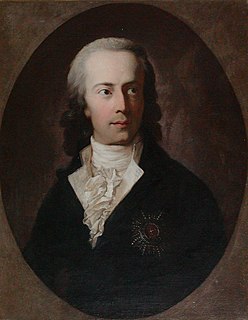
Frederick Christian II, Duke of Schleswig-Holstein-Sonderburg-Augustenburg was a Danish prince and feudal magnate. He held the island of Als and some other castles in Schleswig.

Gråsten Palace is located at Gråsten in the Jutland region of southern Denmark. It is best known for being the summer residence of the Danish Royal Family. The main house has a modern, all-white facade, with Venetian doors opening onto sweeping, manicured lawns and gravel walkways. The grounds include a huge stables court.
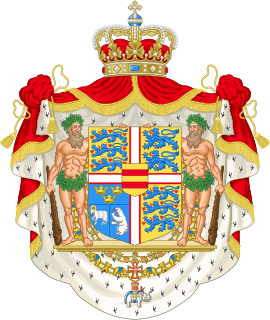
The Monarchy of Denmark is a constitutional institution and a historic office of the Kingdom of Denmark. The Kingdom includes Denmark proper, as well as the autonomous countries of the Faroe Islands and Greenland. The Kingdom of Denmark was already consolidated in the 8th century, whose rulers are consistently referred to in Frankish sources as "kings". Under the rule of King Gudfred in 804 the Kingdom may have included all the major provinces of medieval Denmark. The current unified Kingdom of Denmark was founded or re-united by the Viking kings Gorm the Old and Harald Bluetooth in the 10th century. Originally an elective monarchy, it became hereditary only in the 17th century during the reign of Frederick III. A decisive transition to a constitutional monarchy occurred in 1849 with the writing of the first democratic Constitution, replacing the vast majority of the old absolutist Constitution. The current Royal House is a branch of the princely family of Glücksburg, originally from Schleswig-Holstein in modern-day Germany, the same royal house as the Norwegian and former Greek royal families.

Jacob Fortling was a German-Danish sculptor, architect and industrialist, described as one of the most industrious people in the Denmark of his day. He came to Denmark at age 18 and embarked on a successful career, first as a sculptor and later also as an architect. He was also engaged in the production of building materials, owning several quarries in Norway. Just outside Copenhagen, on Amager's east coast, he founded Kastrup Værk, a large industrial facility combining a lime plant, a brickyard and a pottery.
Frederick Ernest of Brandenburg-Kulmbach was a member of the Brandenburg-Kulmbach branch of the House of Hohenzollern. His most significant position was governor of the Duchies of Schleswig and Holstein-Glückstadt.

Frederick Christian I was Duke of Schleswig-Holstein-Sonderburg-Augustenburg from 1754 to 1794.
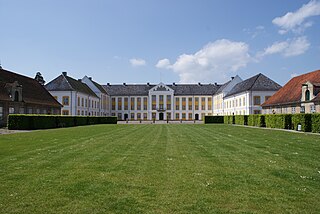
Augustenborg Palace is a Rococo-style palace in the southwestern part of Augustenborg, Als Island, Denmark, overlooking Augustenborg Fjord. The palace owes its name to Duchess Auguste (1633–1701). Augustenborg gave its name to the House of Schleswig-Holstein-Sonderburg-Augustenburg, the last member of which was Duke Christian August II (1798–1869).
Johan Christian Conradi was a German born, Danish master builder, contractor and architect.

Kokkedal Slot is a former country house located in Hørsholm north of Copenhagen, Denmark. It is now operated as a 62-room, high-end hotel under the name Kokkedal Slot Copenhagen to distinguish it from Kokkedal Slot in North Jutland. The hotel is a member of the Small Luxury Hotels of the World (SHL) network. It is surrounded by parkland and an 18-hole golf course.

The Dehn Mansion is one of two identical but mirror-imag Eococo-style town mansions on Bredgade, flanking the entrance to Amalienborg via Frederiksgade, in the Frederiksstaden district of Copenhagen, Denmark. The mansion was divided into two separate properties in the 1910s. The larger, northn part of the mansion is owned by the Danish Association of Pharmaconomists. The southern part is owned by Karberghus.